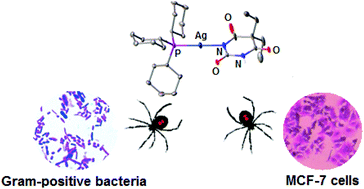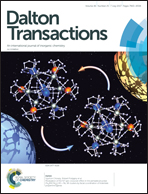Synthesis, structures and biomolecular interactions of new silver(i) 5,5-diethylbarbiturate complexes of monophosphines targeting Gram-positive bacteria and breast cancer cells†
Abstract
A series of new silver(I) 5,5-diethylbarbiturate (barb) complexes with the formulas [Ag2(μ-barb)2(PPh3)2] (1), [Ag(barb)(PPh2Cy)] (2), [Ag(barb)(PPhCy2)] (3) and [Ag(barb)(PCy3)] (4) (PPh3 = triphenylphosphine, PPh2Cy = diphenylcyclohexylphosphine, PPhCy2 = dicyclohexylphenylphosphine and PCy3 = tricyclohexylphosphine) were synthesized and fully characterized by elemental analysis, IR, NMR, ESI-MS and X-ray crystallography. All the complexes display a significant affinity towards DNA with a groove binding mode and also strongly bind to BSA via hydrophobic interactions. Lipophilicity increases from 1 to 4 with an increasing number of Cy groups in the phosphine ligands. Screening of the in vitro antimicrobial activity of 1–4 against the strains of Gram-negative (S. typhimurium ATCC 14028, E. coli ATCC 25922 and O157:H7) and Gram-positive (L. garvieae 40456, S. aureus ATCC 25923, and ATCC 33591) bacteria demonstrated that all the complexes exhibit very high activity and specific selectivity against the Gram-positive bacteria, compared to AgNO3 and silver sulfadiazine. Furthermore, the growth inhibitory effects of 1–4 on four human cancer cell lines (MCF-7, PC-3, A549 and HT-29) showed that 4 has a potent cytotoxic activity against MCF-7 cells, significantly higher than cisplatin and carboplatin. The effects of the complexes on the inhibition of the cells are closely related to their lipophilicity as well as DNA/protein binding. The induction of apoptosis of MCF-7 cells treated with 4 was probed through Hoechst 33342 staining, Annexin V positivity and caspase 3/7 activity. In addition, increased ROS levels in the presence of 4 are most likely responsible for damage to both mitochondria and genomic DNA.



 Please wait while we load your content...
Please wait while we load your content...